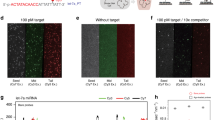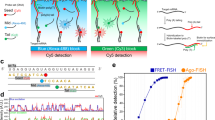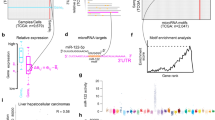Abstract
MicroRNAs (miRNA) are short endogenous noncoding RNA molecules that regulate fundamental cellular processes such as cell differentiation, cell proliferation and apoptosis through modulation of gene expression. Critical to understanding the role of miRNAs in this regulation is a method to rapidly and accurately quantitate miRNA gene expression. Existing methods lack sensitivity, specificity and typically require upfront enrichment, ligation and/or amplification steps. The Direct miRNA assay hybridizes two spectrally distinguishable fluorescent locked nucleic acid (LNA)-DNA oligonucleotide probes to the miRNA of interest, and then tagged molecules are directly counted on a single-molecule detection instrument. In this study, we show the assay is sensitive to femtomolar concentrations of miRNA (500 fM), has a three-log linear dynamic range and is capable of distinguishing among miRNA family members. Using this technology, we quantified expression of 45 human miRNAs within 16 different tissues, yielding a quantitative differential expression profile that correlates and expands upon published results.
This is a preview of subscription content, access via your institution
Access options
Subscribe to this journal
Receive 12 print issues and online access
$259.00 per year
only $21.58 per issue
Buy this article
- Purchase on Springer Link
- Instant access to full article PDF
Prices may be subject to local taxes which are calculated during checkout





Similar content being viewed by others
References
Lee, R.C., Feinbaum, R.L. & Ambros, V. The C. elegans heterochronic gene lin-4 encodes small RNAs with antisense complementarity to lin-14. Cell 75, 843–854 (1993).
Reinhart, B. et al. The 21-nucleotide let-7 RNA regulates developmental timing in Caenorhabditis elegans. Nature 403, 901–906 (2000).
Houbaviy, H.B., Murray, M.F. & Sharp, P.A. Embryonic stem cell-specific MicroRNAs. Dev. Cell 5, 351–358 (2003).
Chen, C.Z., Li, L., Lodish, H.F. & Bartel, D.P. MicroRNAs modulate hematopoietic lineage differentiation. Science 303, 83–86 (2004).
Brennecke, J., Hipfner, D.R., Stark, A., Russell, R.B. & Cohen, S.M. bantam encodes a developmentally regulated microRNA that controls cell proliferation and regulates the proapoptotic gene hid in Drosophila. Cell 113, 25–36 (2003).
Michael, M.Z., O' Connor, S.M., van Holst Pellekaan, N.G., Young, G.P. & James, R.J. Reduced accumulation of specific microRNAs in colorectal neoplasia. Mol. Cancer Res. 1, 882–891 (2003).
Calin, G.A. et al. MicroRNA profiling reveals distinct signatures in B cell chronic lymphocytic leukemias. Proc. Natl. Acad. Sci. USA 101, 11755–11760 (2004).
He, L. et al. A microRNA polycistron as a potential human oncogene. Nature 435, 828–833 (2005).
Johnson, S.M. et al. RAS is regulated by the let-7 microRNA family. Cell 120, 635–647 (2005).
Kim, V.N. MicroRNA biogenesis: coordinated cropping and dicing. Nat. Rev. Mol. Cell Biol. 6, 376–385 (2005).
Yi, R., Qin, Y., Macara, I. & Cullen, B.R. Exportin-5 mediates the nuclear export of pre-microRNAs and short hairpin RNAs. Genes Dev. 17, 3011–3016 (2003).
Nelson, P.T. et al. Microarray-based, high-throughput gene expression profiling of microRNAs. Nat. Methods 1, 155–161 (2004).
Yanagida, T., Kitamura, K., Tanaka, H., Hikikoshi Iwane, A. & Esaki, S. Single molecule analysis of the actomyosin motor. Curr. Opin. Cell Biol. 12, 20–25 (2000).
Schwille, P., Bieschke, J. & Oehlenschlager, F. Kinetic investigations by fluorescence correlation spectroscopy: the analytical and diagnostic potential of diffusion studies. Biophys. Chem. 66, 211–228 (1997).
Li, H., Ying, L., Green, J.J., Balasubramanian, S. & Klenerman, D. Ultrasensitive coincidence fluorescence detection of single DNA molecules. Anal. Chem. 75, 1664–1670 (2003).
Schwille, P., Kummer, S., Heikal, A.A., Moerner, W.E. & Webb, W.W. Fluorescence correlation spectroscopy reveals fast optical excitation-driven intramolecular dynamics of yellow fluorescent proteins. Proc. Natl. Acad. Sci. USA 97, 151–156 (2000).
Anazawa, T., Matsunaga, H. & Young, E.S. Electrophoretic quantitation of nucleic acids without amplification by single-molecule imaging. Anal. Chem. 74, 5033–5038 (2002).
Ambrose, W.P. et al. Detection system for reaction-rate analysis in a low-volume proteinase-inhibition assay. Anal. Biochem. 263, 150–157 (1998).
Dovichi, N.J., Martin, J.C., Jett, J.H., Trkula, M. & Keller, R.A. Laser-induced fluorescence of flowing samples as an approach to single-molecule detection in liquids. Anal. Chem. 56, 348–354 (1984).
Dundr, M., McNally, J.G., Cohen, J. & Misteli, T. Quantitation of GFP-fusion proteins in single living cells. J. Struct. Biol. 140, 92–99 (2002).
Miska, E.A. et al. Microarray analysis of microRNA expression in the developing mammalian brain. Genome Biology 5, R71.1–R71.15. (2004).
Baskerville, S. & Bartel, D.P. Microarray profiling of microRNAs reveals frequent coexpression with neighboring miRNAs and host genes. RNA 11, 241–247 (2005).
Barad, O. et al. MicroRNA expression detection by oligonucleotide microarrays: System establishment and expression profiling in human tissues. Genome Res. 14, 2486–2494 (2004).
Korn, K. et al. Gene expression analysis using single molecule detection. Nucleic Acids Res. 31, e89 (2003).
Castro, A. & Williamson, J.G.K. Single molecule detection of specific nucleic acid sequences in unamplified genomic DNA. Anal. Chem. 69, 3915–3920 (1997).
Chan, E.Y. et al. DNA mapping using microfluidic stretching and single-molecule detection of fluorescent site-specific tags. Genome Res. 14, 1137–1146 (2004).
Eigen, M. & Rigler, R. Sorting single molecules: applications to diagnostics and evolutionary biotechnology. Proc. Natl. Acad. Sci. USA 91, 5740–5747 (1994).
Nie, S., Chiu, D.T. & Zare, R.N. Real time detection of single molecules in solution by confocal fluorescence microscopy. Analytical Chemistry 67, 2849–2857 (1995).
Brinkmeier, M., Dorre, K., Stephan, J. & Eigen, M. Two beam cross correlation: A method to characterize transport phenomena in micrometer-sized structures. Anal. Chem. 71, 609–616 (1999).
R Development Core Team. R: A language and environment for statistical computing, R foundation for computing. Vienna, Austria (2005) ISBN 3-900051-07-0.
Acknowledgements
We thank our collaborator A.C. Eklund for generating the heat maps and conducting the hierarchical clustering and M. Barth for help preparing the figures. We thank all of our colleagues at US Genomics especially D. Hoey, R. Gilmanshin, J. Larson, E. Nalefski and A. Maletta for fostering fruitful scientific discussion. We thank L. Kunkel, F. Boeckman and D. Whitney for critical review of the manuscript.
Author information
Authors and Affiliations
Corresponding author
Ethics declarations
Competing interests
The authors are presently or were formerly US Genomics employees.
Supplementary information
Supplementary Fig. 1
Northern blots confirm the tissue-specific expression patterns observed by our single molecule method. (PDF 225 kb)
Supplementary Table 1
Sequences of the LNA/DNA chimeric probes used in this study. (PDF 53 kb)
Rights and permissions
About this article
Cite this article
Neely, L., Patel, S., Garver, J. et al. A single-molecule method for the quantitation of microRNA gene expression. Nat Methods 3, 41–46 (2006). https://doi.org/10.1038/nmeth825
Received:
Accepted:
Published:
Issue Date:
DOI: https://doi.org/10.1038/nmeth825
This article is cited by
-
Single-molecule amplification-free multiplexed detection of circulating microRNA cancer biomarkers from serum
Nature Communications (2021)
-
Small molecule electro-optical binding assay using nanopores
Nature Communications (2019)
-
Ultrasensitive detection of miRNA with an antimonene-based surface plasmon resonance sensor
Nature Communications (2019)
-
Advanced methods for microRNA biosensing: a problem-solving perspective
Analytical and Bioanalytical Chemistry (2019)
-
Gold-coated nanoporous polycarbonate track–etched solid platform for the rapid detection of mesothelin
Ionics (2019)



